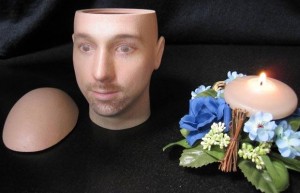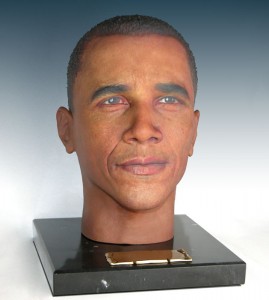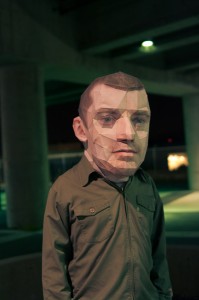
England’s Telegraph is running a “Best Pictures of The Year” gallery to wrap up 2009…and with images like the above from the “Weird Inventions” gallery — or even from their other bizarre and weird and spectacular galleries — one can only marvel over what a strange year it’s been…and how remarkably stranger it is going to get as we move into the second decade of the 21st century.
The photo above is a “personalized urn” that British firm Cremation Solutions can create, using 3-D facial reconstruction software. There is obviously an uncanny element to this urn, which reduces the body into ash stored into a simulacrum of one of its components — a dismembered head with a removable skullcap — in the form of an unblinking mannequin head whose features bare an alarming similarity to the dearly departed.
Curious to find out more about this product, I visited Cremation Solutions online, and after browsing some interesting “fingerprint jewelry”, quickly turned to their stunning catalog page for the personal urn. I call it “stunning” because I hadn’t expected to encounter an urn for President Obama!

At first I was taken aback by the image, both because of the accuracy of the likeness and because of the unexpected treatment of a living person, as if he were already dead. As it sunk in, I realized that most presidential figures and celebrities — indeed, anyone whose image is popular — are memorialized in a similar fashion, having their images frozen into postage stamps and plaster busts — and so, conceptually, this tribute is not so aberrant. But the uncanny is still omnipresent in the unblinking return of the gaze, the doppelganger of the dead person permanently placed on your mantle. There’s a reason why graveyards spook us: they are the spaces where the dead “live”; cremation urns can respect the role of the dead in a loving family’s home, but the more lifelike the urn, the more uncanny it becomes, making the boundaries between life and death — subject and object — very blurry. The commercial marketing of such memorials, both loved ones and celebrities, sold “on demand” (just $2600 for an urn that can hold all the ashes; $600 for a smaller keepsake), integrating the unfamiliar “magic” of high technology with the domestic familiarity of family photographs, brings this into the realm of the popular uncanny.
I could go on and on about the stock elements of the unheimlich in these urns. But one thing this particular practice brings to mind is a rising cultural trend toward employing 3D image rendering in ways that clone or replicate us. The art world seems to be responding to this with great interest. Visit the WebDesigner’s Depot on “Mind-Blowing Hyperrealistic Sculptures” or Eric Testroete’s Papercraft Self-Portrait series to muse over the implications and potentials of all this technology. I suspect we’ll see many more “personalized” objects mapped off images of ourselves or popular images in the media — there’s no end to our sense of wonder about ourselves, but one has to also wonder where natural fascination ends and cultural narcissism begins.

[Thanks to Tim Dedopulos (@ghostwoods) for alerting us about the Telegraph photo on Twitter. (I’m @MikeArnzen on twitter, btw).]
I can see the appeal in this type of iconography…I mean, who hasn’t dreamt of their own wax figure in Madame Trousseau’s standing right next to Marilyn or Elvis?